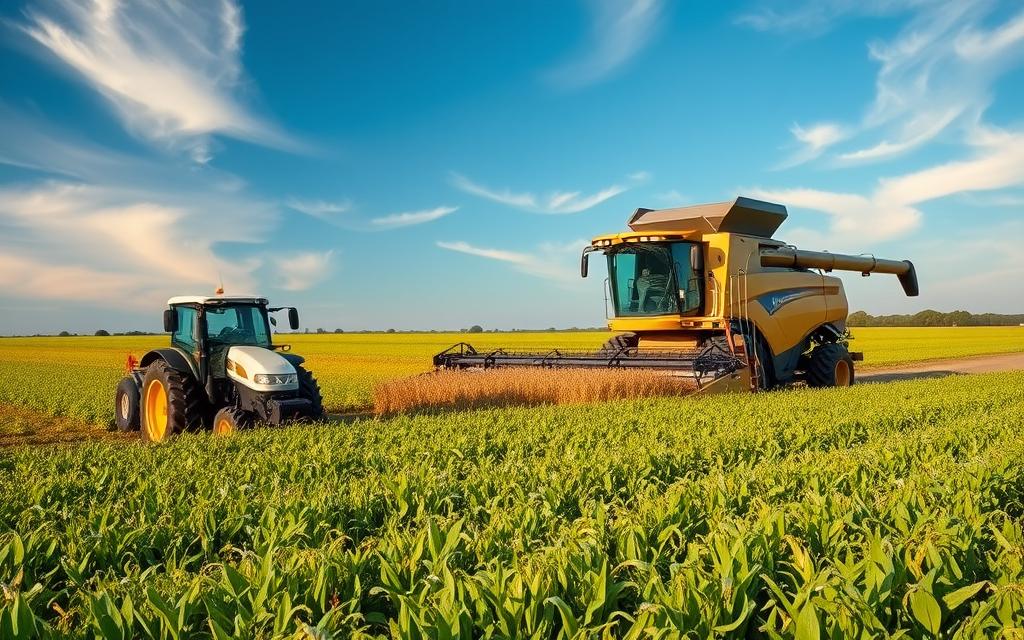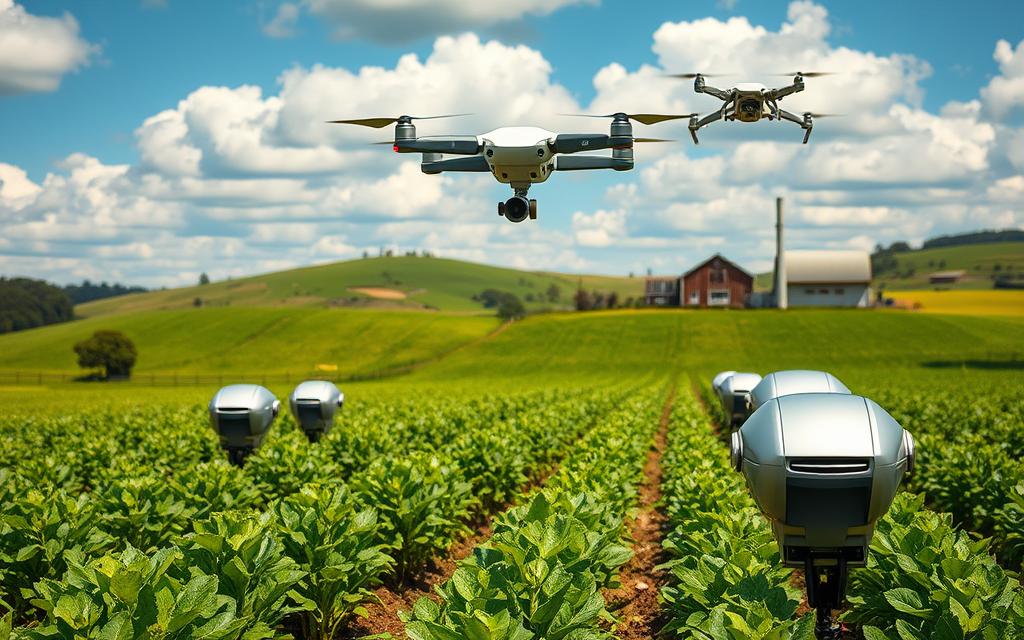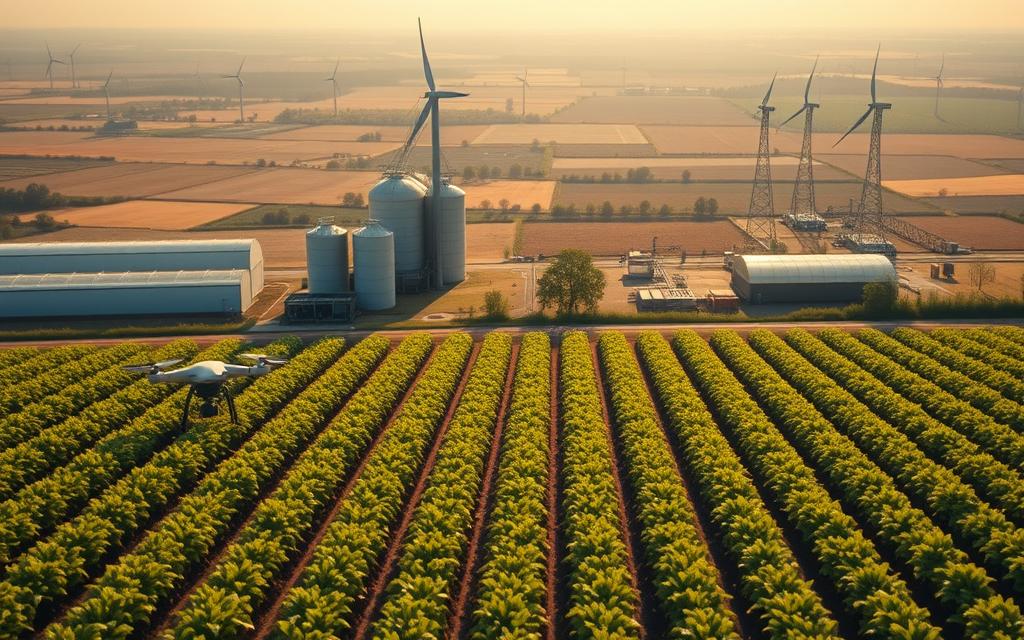Global agriculture is facing big challenges. The UN says food demand will rise by 70% by 2050. Old ways can’t keep up, leading to a new approach.
This new way uses data-driven decisions. It changes how we farm, from Canada to Australia.
Dr. Keshav Singh at Agriculture and Agri-Food Canada is leading this change. His team uses digital phenomics research and hyperspectral imaging. This lets farmers check crop health with great detail.
Such tech helps farmers spot problems early. It’s a big win for growing more food.
Kingstec’s work shows the power of these technologies. They’ve seen 23% yield improvements in crops. This is thanks to IoT in irrigation.
These smart tools do more than just increase food. They also help with fewer workers and changing weather. They keep an eye on fields in real-time.
Soil sensors and AI for harvests are changing farming. As more people need food and land is less, tech is key. It’s not just helpful; it’s necessary for feeding the world.
The Digital Transformation of Farming Practices
Farmers around the world are changing how they farm. They are moving from old ways to new, high-tech methods. This change brings together old knowledge and new data, making farming better.
From Traditional Methods to Data-Driven Agriculture
Historical Context of Agricultural Evolution
The change in farming is huge. It has gone from using horses to using satellites. This shows how farming has evolved over time.
| Era | Timeframe | Key Technologies |
|---|---|---|
| Mechanisation | 1900-1940 | Tractors, combine harvesters |
| Green Revolution | 1960-2000 | Chemical fertilisers, hybrid seeds |
| Digital Age | 2010-present | IoT sensors, machine learning |
A study in 2023 looked at 1,200 farms. It found 74% of early adopters cut water use by 30% in two years. But, some farmers in Saudi Arabia face issues with IoT connectivity.
Key Drivers of Technological Adoption
Three main things are pushing farming to use more technology:
- More people need food, and by 2050, we’ll need 60% more (UN)
- Weather changes mean we need climate-smart agriculture solutions
- Not enough workers means we need robots to help with harvesting
“The average farm now generates 0.5 million data points daily – more than most Wall Street trading floors.”
Smart farming is growing fast, with a 18.4% CAGR from 2019. But, it’s not easy. Only 37% of US farmers feel confident using new farm software.
How Does Technology Affect Agricultural Productivity?
Modern farming has seen a big change thanks to real-time data analysis and automated systems. These systems work better than old methods. They help farmers from planting seeds to moving crops.

Precision Agriculture Techniques
Companies like John Deere show how precision farming equipment changes farming. Their AutoTrac system lets tractors follow GPS paths with great accuracy. This means less wasted effort during planting.
Studies by Agriculture and Agri-Food Canada found this tech boosts crop yields by 25%. It does this by placing seeds more efficiently.
GPS-guided machinery implementation
Autonomous tractors now cover more ground each day than ones driven by people. They also use less fuel. Farmers say they make 40% fewer mistakes when planting.
Drone-based field monitoring systems
DJI’s Agras T40 spray drones show how drones can be precise. They spray fertilisers up to 30cm from where they’re needed. This helps avoid using too much chemical and quickly tackles pests.
Yield Optimisation Strategies
Checking soil health is key for better crop yield optimisation. Kingstec’s wireless sensors keep track of 12 soil factors. This lets farmers fix nutrient issues early.
Soil sensor networks in practice
Farmers in Saskatchewan used sensors to cut fertiliser use by 40% without losing yield. The sensors found hidden nitrogen that tests missed.
Variable-rate technology applications
Modern spreaders adjust how much they apply every 10 metres based on soil data. This method saves resources in areas that don’t grow well. It also uses more in areas that do.
“Variable-rate systems let us treat each square metre as its own management zone. We’ve moved beyond blanket field treatments forever.”
Internet of Things (IoT) in Crop Management
IoT sensors are changing how farmers manage crops and livestock. These IoT agriculture solutions link everything together. They turn every drop of water and animal move into useful data. This mix of hardware and analytics brings new precision and cuts waste.
Smart Irrigation Systems
Today’s farms use IoT for smart irrigation. It matches water with crop needs, avoiding old methods’ uncertainty. This is key in dry areas.
Climate-Smart Water Distribution
In Alberta, IoT irrigation is making a big difference. It uses sensors to adjust watering based on weather, soil, and crop growth. This climate-smart method has cut water use by 30% without lowering yields.
Soil Moisture Monitoring Solutions
Underground sensors check soil moisture levels. They only water when needed. A California vineyard saved 22% on water costs with this system.
Livestock Tracking Innovations
IoT also changes how we track animal health and habits. It tackles two big issues: stopping diseases and tracking productivity.
RFID Tagging Implementations
In Ontario, RFID tags track dairy cows. They monitor milk, feeding, and breeding. One farm with 500 cows increased its yield by 15% with this info.
Health Monitoring Wearables
Biometric collars and tags spot illness early. They watch for temperature changes or activity drops. With Kingstec’s alerts, farmers get quick warnings of health issues.
“IoT isn’t just about gadgets – it’s about creating responsive agricultural ecosystems.”
These techs are part of a bigger trend. For example, AAFC’s AI weed detection helps with herbicides, saving £2.1 million a year. IoT fire systems also speed up emergency responses, protecting crops and buildings.
Artificial Intelligence in Farm Operations
Modern farms are using artificial intelligence to solve old problems with new precision. These AI farming tools are real and making a big difference in North America’s heartland.

Machine Learning: The Farm’s New Crystal Ball
Advanced algorithms can now predict farm outcomes with amazing accuracy. In Alberta, Dr. Priya Singh’s wheat rust detection system uses weather and crop data. It’s right 92% of the time, 14 days early.
Disease prediction algorithms
Some key uses include:
- AAFC’s lentil desiccation models cut harvest losses by 18%
- Saskatchewan’s satellite forecasts are off by just ±5%
- Manitoba’s potato blight system warns early
Yield forecasting models
These systems mix past data with current info to:
- Time fertiliser use perfectly
- Guess crop ripeness within 3 days
- Figure out storage needs 6 months ahead
Computer Vision: The Farmer’s Digital Eyes
Field-ready visual systems are changing quality checks. Kingstec’s AI sorters handle 12 tonnes of pulses an hour. They:
Weed detection technology
- Spot 97 weed types with 94% accuracy
- Lower herbicide use by 35% in Iowa tests
- Move fast over rough ground
Automated quality control
Manitoba’s potato grading uses hyperspectral imaging to:
- Find hidden bruises
- Sort into 7 top-quality groups
- Meet EU standards 40% better
These breakthroughs show AI is not replacing farmers. It’s giving them incredible powers to feed more people.
Agricultural Automation Advancements
Modern farms are using robotics and smart systems to make things easier and cheaper. They have self-driving machines and AI-driven quality control to change how we get our food.
Autonomous Machinery
Driverless tech is not just for cars. John Deere’s 8R tractor cut fuel use by 15% in Iowa corn trials. It works all day, every day, without overtime, and is very accurate.
Self-driving tractors (John Deere models)
The 8R series uses real-time field mapping to:
- Adjust seeding depth based on soil moisture
- Auto-correct path overlaps
- Sync with weather forecasts for optimal scheduling
Robotic harvesters (Agrobot solutions)
Agrobot’s F3 strawberry picker picks fruit with 98% accuracy. It uses:
- 3D vision sensors to check ripeness
- Pressure-sensitive grippers
- Automatic stem-trimming blades
Growers in California save 34% on labour costs per acre with it.
Automated Sorting Systems
Sorting fruit after it’s picked has also changed a lot. In British Columbia, Kingstec optical sorters sort 22 tonnes of apples an hour. They cut waste by 22% with special imaging.
Optical grading technology
These systems find problems that people can’t see, like:
- Internal bruising via NIR scanners
- Sugar content analysis
- Size calibration within 0.5mm tolerance
AI-powered packing lines
These systems work with AI in farming to change packaging based on what’s needed. A place in Washington state packs orders 18% faster now.
Sustainable Technology Solutions
Modern farming balances growth with care for the environment. Eco-friendly farming cuts down greenhouse gas emissions by 30%. This is shown in Agriculture and Agri-Food Canada’s studies on fertiliser use.
Using precision tools, farmers reduce chemical use a lot. Drone spraying systems cut down pesticide use by 40% in 2023 studies. Kingstec’s GPS-guided applicators also help avoid waste by targeting areas precisely.
Monitoring livestock with RFID tags lowers methane emissions by 35%. This shows how smart tech helps animals and the planet.
Soil health is key to sustainable farming. AAFC’s models help prevent 12,000 tonnes of fertiliser runoff in US farms each year. Sensors track soil moisture, saving 20% more water than old methods.
Leaders in the industry are setting goals for greener farming. Kingstec wants to reach net-zero by 2035. They plan to use solar power and AI to manage resources better.
These new methods show that green farming doesn’t mean giving up. Data-driven farming protects nature and ensures food for all. As tech improves, farming will become more sustainable, blending profit with planet care.







